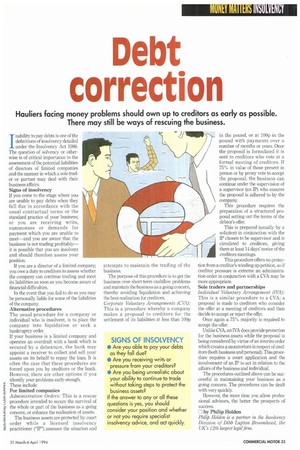Debt correction
Page 37

If you've noticed an error in this article please click here to report it so we can fix it.
Inability to pay debts is one of the definitions of insolvency detailed under the Insolvency Act 1986. The question of solvency or otherwise is of critical importance to the assessment of the potential liabilities of directors of limited companies and the manner in which a sole trader or partner may deal with their business affairs.
Signs of insolvency
If you come to the stage where you are unable to pay debts when they fall due in accordance with the usual contractual terms or the .
standard practice of your business; or you are receiving writs, summonses or demands for payment which you are unable to meet—and you are aware that the
business is not trading profitably—
it is possible that you are insolvent
and should therefore assess your nit, position.
If you are a director of a limited company, you owe a duty to creditors to assess whether the company can continue trading and meet its liabilities as soon as you become aware of financial difficulties, In the event that you fail to do so you may be personally liable for some of the liabilities of the company.
Alternative procedures
The usual procedure for a company or individual who is insolvent, is to place the company into liquidation or seek a bankruptcy order.
If your business is a limited company and operates an overdraft with a bank which is secured by a debenture, the bank may appoint a receiver to collect and sell your assets on its behalf to repay the loan, It is often the case that these procedures are forced upon you by creditors or the bank. However, there are other options if you identify your problems early enough.
These include:
For limited companies
Administration Orders: This is a rescue procedure intended to secure the survival of the whole or part of the business as a going concern, or enhance the realisation of assets.
The business assets are protected by court order while a licensed insolvency practitioner ("IP") assesses the situation and attempts to maintain the trading of the business.
The purpose of this procedure is to get the business over short-term cashflow problems and maintain the business as a going concern, thereby avoiding liquidation and achieving the best realisation for creditors.
Corporate Voluntary Arrangements (CVA): This is a procedure whereby a company makes a proposal to creditors for the settlement of its liabilities at less than 100p
in the pound, or at 100p in the pound with payments over a number of months or years. Once the proposal is formulated it is sent to creditors who vote at a formal meeting of creditors. If 75% in value of those present in person or by proxy vote to accept the proposal, the business can continue under the supervision of a supervisor (an IF) who ensures the proposal is adhered to by the company.
This procedure requires the preparation of a structured proposal setting out the terms of the debtor's offer.
This is prepared (usually by a solicitor) in conjunction with the IP chosen to be supervisor and is circulated to creditors, giving them at least 14 days' notice of the creditors meetings.
This procedure offers no protection from a creditor's winding up petition, so if creditor pressure is extreme an administration order in conjunction with a CVA may be more appropriate.
Sole traders and partnerships
Individual Voluntary Arrangement (IVA): This is a similar procedure to a CVA; a proposal is made to creditors who consider the offer at a meeting of creditors and then decide to accept or reject the offer.
Once again a 75 ?.'". majority is required to accept the offer.
Unlike CVA, an NA does provide protection for the business assets while the proposal is being considered by virtue of an interim order which creates a moratorium in respect of creditors (both business and personal). This procedure requires a court application and the involvement of an IP to act in relation to the affairs of the business and individual.
The procedures outlined above can be successful in maintaining your business as a going concern. The procedures can be dealt with very quickly.
However, the more time you allow professional advisors, the better the prospects of success.
El by Philip Holden
Philip Holden is a partner in the Insolvency Division of Dibb Lupton Broomhead, the UK's 12th largest legal firm.






























































































